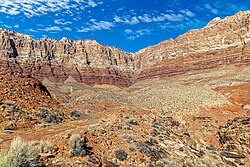This article needs additional citations for verification .(December 2009) |



The Vermilion Cliffs are the second "step" up in the five-step Grand Staircase of the Colorado Plateau, in northern Arizona and southern Utah in the southwestern United States. [1] They extend west from near Page, Arizona, for a considerable distance, in both Arizona and Utah.
Contents
112,500 acres (45,500 ha) of the region were designated as the Paria Canyon-Vermilion Cliffs Wilderness in 1984. An even greater area was protected within Vermilion Cliffs National Monument in 2000.
